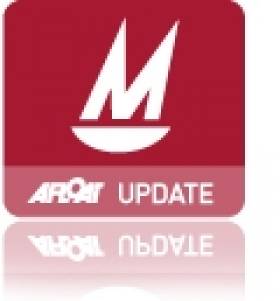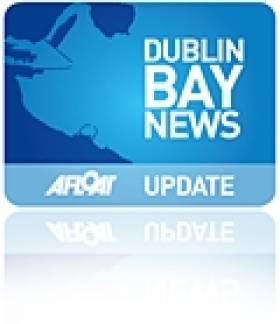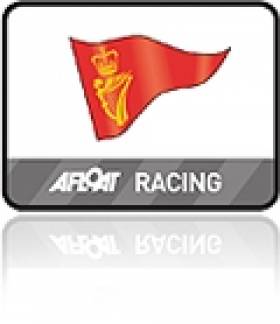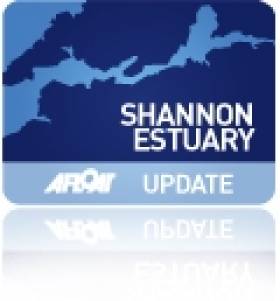Displaying items by tag: Dinghy
National 18s Take Dinghy Racing Class Onto A New Plane
#national18 – There are some special dinghy classes. There are some very special dinghy classes. And then there are the National 18s.
You can see any number of reasons why this unique class, celebrating its 80th birthday in just three years time, is in a league of its own. A three-man boat with one of the crew on a trapeze, its crewing set–up requires a level of sociability which is further emphasised ashore, where their après sailing is the stuff of legend.
At all the centres where it is sailed, and at places upon which the National 18s have descended for a championship, we know they've left behind a formidable reputation for determined but good humoured conviviality, combined with great sportsmanship.
Yet while it is easy to understand the class's popularity among its adherents when you see them in high spirits as a group, there's no getting away from the fact that in today's dinghy terms, 18ft is a lot of boat. The mood of the National 18s may often seem light-hearted. But keeping one of these boats in prime condition and well crewed is not something for the casually-interested.
It requires real commitment, yet that is something which National 18 sailors seem to have in spades. And now the class has taken on a new lease of life with the development of a fresh take on the National 18 parameters by legendary designer Phil Morrison. But rather than being launched as a commercial venture, the new boat is being developed from within class resources, which has involved several imaginative fund-raising ventures. W M Nixon found himself being drawn into one of them.
It's official, The Cork Harbour National 18 Class are brilliantly capable of running a booze-up in a distillery. And just to make it even more challenging for their supportive members and many friends, they ran this particular fund-raiser for the new Phil Morrison boat in the Jameson Distillery in Midleton in East Cork on the first Saturday night of Lent.
Of course, like all Ireland on St Patrick's Day three weeks later, they got a special dispensation for the partying to continue unhindered by thoughts of Lenten piety. There was plenty of time for that next morning. But meanwhile, right there in the heritage and high tech splendour of the Midleton facility where tradition and new science are dynamically allied, the National 18 crews went at it good-oh, and the class's Development Fund was greatly enhanced.
In fact, I'm told the financial targets were comfortably exceeded, but as Class President Dom Long and the ever-energetic Tom Dwyer didn't tell us the targets in the first place, we'll happily take their word for it. All I know is that it was one helluva night, and only the National 18s could have done it.

Let's party! Colman Garvey's vintage National 18 welcomes guests to the Midleton Distillery for yet another event in a series of fund-raisers which have supported the development of the new boat from within class resources. Photo: W M Nixon
It's a class which – thanks to being a restricted design rather than a hidebound one-design – is able to wallow happily in its history as it thrusts towards new designs which keep up the spirits of its established sharpest sailors, while also encourage the vital new blood.
So how did it all come about? Well, thanks to a prodigious book written by Brian Wolfe of the boat's history, published in 2013 to mark the class's 75th Anniversary, we get some idea of the inevitable complexity of the story. The class started in 1938 in the Thames Estuary where there'd been several local one design or restricted "large dinghy" classes around the 18ft mark and soon – under a National Class imprimatur from the Yacht Racing Association – it spread to several other centres.
Needless to say, World War II from 1939 to 1945 brought any further growth and most sailing activity to a halt, but by 1947 things were looking up again, and in the straitened post war circumstances, the National 18 found its niche. Back in 1938, Yachting World magazine had sponsored a design to the class's rules by Uffa Fox, and that became the clinker-built Uffa Ace, which continued to be the backbone of the class for many years after the war.
It was Whitstable in the far east of Kent which produced most of the initial impetus for the class, and local builders Anderson, Rigden & Perkins made a speciality of it. In fact, ARP-built Uffa Aces were soon virtually the definitive National 18. Yet ironically we cannot confirm at the moment if the oldest National 18 still sailing – Richard Stirrup's 1938-vintage Tinkerbelle which races with the classics divison at Bosham SC on Chichester Harbour – is an ARP boat.
It's ironic because Tinkerbelle's first home port was Howth. It wasn't until I was writing the history of Howth YC for its Centenary twenty years ago that awareness surfaced that there'd been the nucleus of a National 18 class in Howth in 1938.
There were just three boats – John Masser's Wendy number 14, Tinkerbelle number 15, and Fergus O'Kelly & Pat Byrne's Setanta, number 16.

Tinkerbelle (15) being sailed by Aideen Stokes in 1939, with John Masser's Nat 18 Wendy (later Colleen II) astern, and the Corbett family's Essex OD Cinders abeam.
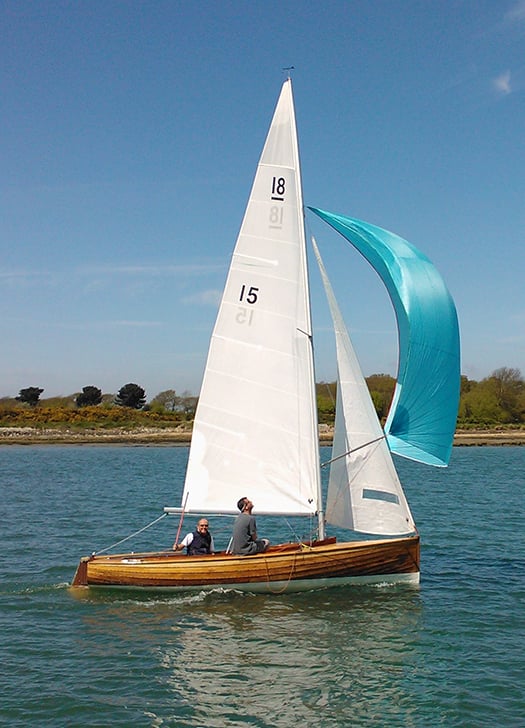
Tinkerbelle as she is today, the oldest National 18 still sailing. Her home port is Bosham on Chichester Harbour. Photo courtesy Richard Stirrup
Tinkerbelle seems to have been owned by a syndicate in which the Stokes family was much involved, though in the class history her earliest owner is listed as Bobby Mooney, son of the renowned Billy Mooney of Aideen fame. However, around Howth, Tinkerbelle was best remembered for being raced with considerable panache by a non-owner, Norman Wilkinson.
But when Norman returned from war service in 1946 determined to sail just as much as humanly possible, he found that the National 18s had faded away, and the only way he could get regular racing was by buying the 1898-built Howth 17 Leila, which he duly raced with frequent success right up to the end of his long life in 1998, by which time Leila was a hundred.
It's intriguing to think that, with one or two twists of fate in Howth, Norman Wilkinson might have been renowned as a star of the National 18s taking on the likes of class legends such as Somers Payne and Charlie Dwyer of Cork, where the class – having started with just two ARP boats in1939 - held fire for a while, but got going big time in the late 1940s and early '50s with several builders all round Cork Harbour creating them in local workshops.
That was one of the attractions of the National 18s. They were big enough to appeal to people who didn't fancy skittish little dinghies, yet they were small enough to be constructed by artisan boatbuilders who could produce lovely boats. But the owners – having laid out what were considerable sums of money at a time when Ireland seemed to be in a state of permanent economic depression – were disinclined to go the final stage of having the boats properly measured and registered with the class. This caused increasing problems, ultimately solved by a high level of diplomacy as the National 18s' popularity grew, and the opportunities arose for the Cork boats to go across the water to race in big-fleet competitions.
At one stage, class numbers were so healthy at many centres that in Britain they had Northern and Southern Championships, reflecting the primitive state of road movement of boats. Dinghy road trailers – particularly for hefty big 18-footers – were still in their infancy, so all sorts of ingenious methods were used to get boats to distant events, with a Whitstable boat on at least one occasion getting to Cork as deck cargo aboard a Coast Lines vessel on its regular route which took in Rochester in Kent and eventually Cork among several ports.

The National 18s in their classic prime, with immaculately vanished clinker-built hulls, and setting lovingly-cared-for cotton sails. Here, Crosshaven's greatest National 18 sailor Somers Payne (Melody, 206) is being pursued by Alan Wolfe in Stardust 63), while up ahead Charlie Dwyer with Mystic (208) is doing a horizon job, with the legendary Leo Flanagan of Skerries lying second at the helm of Fingal. The photo was taken during a Dinghy Week at Baltimore, and it is memories like this which inspired Brian Wolfe (son of Stardust's owner-skipper) to undertake the mammoth task of collating and writing the class's history.
In Ireland, centres which saw interest in the National 18s included Dunmore East, Clontarf and Portrush, but as Dun Laoghaire was committed to the 17ft Mermaid, the only place on the East Coast with really significant National 18s numbers was Skerries, where the incredible Leo Flanagan set the pace driving his Jensen Interceptor ashore, and racing his no-expenses-spared ARP-built National 18 Fingal afloat in somewhat erratic style.
Leo was a ferocious party animal, and when the Skerries and Crosshaven National 18s united in going to the big class championship at Barry in South Wales in the mid 1950s, Leo was very disappointed to discover that, just as the party was really getting going, the club barman had every intention of closing at closing time. The very idea....Leo solved the problem by buying the entire bar for cash on the spot.
As far as Leo was concerned, sailing was for parties, so when he heard of the highly-organised Irish Olympic campaign towards the 1960 Olympics in Rome, he got himself to Rome, as Olympic sailing promised Olympian parties. To his distress, he was ordered out of the Olympic Village by the Irish squad, who wanted no distractions. But to their distress, the bould Leo then turned up next morning for the first day's racing, officially accredited and highly visible in his new role – he had become manager of the Singapore team.
It seems that in a harbourside bar the night before, he'd met the helmsman of the Singapore Olympic Dragon (as it happened, the only Dragon in Singapore), who was racing in the Olympics as a personal venture. As the biggest rubber concessionaire in Malaya, he could well afford to do so. But this meant he was also Team Manager, and when Leo met him, the Singapore skipper was much upset, because with his sailing duties and need to get a good night's sleep before each day's racing, he was simply unable to take up all the official invitations which any Olympic Team Manager received.
He felt he was badly offending his hosts, and completely failing the Singapore sailing community So Leo, out of sheer kindness, agreed to be the Singapore Olympic Sailing Team Manager, giving selflessly of his time, energy and great wit in the front line at all the best and most fashionable parties throughout the 1960 Olympic Regatta.
All of which has little enough direct connection with the story of the National 18s, but it gives you some idea of the style of the people who have been involved in a long tale which will soon have been going on for eighty years. Yet beyond the parties and the many scrapes they got into, there was also much serious sailing and boat development going on, for although the Uffa Ace was the most numerous design in the growing fleet, anyone could have a go provided they fitted within the class rules.
But by the mid-1960s, it was clear that the traditional concept of a clinker-built National 18 was losing its appeal, and in 1968 the Class Association asked Ian Proctor to design a National 18 to be built as a smooth-hulled fibreglass series-produced boat, with bare hulls to be available for owners who wished to finish the boats themselves.
However, being mindful of keeping existing wooden boats competitive, the new boats were built much heavier than their glassfibre construction really required. Yet they looked good, and the first one Genevieve (266) was delivered to class stalwart Murray Vines, who sailed with the Tamesis Club on the Thames. There, the river may have been pretty, but it was so narrow that when the Tamesis people secured a major championship, they took their entire race management team down to the coast to attractive sea venues where the National 18s could do their thing with style and space.
That said, it was far from style and space they were reared. Murray Vines' son Jeremy – who is proud owner of the very first production version of the Phil Morrison Odyssey design which the class has been developing for the past two years – recalls his own earliest experience of championship competition with the National 18s in 1949 aged 11. He and his brother crewed for their father in 18/51 in a championship on the Medway in Kent, and they lived afloat on the boat, for in those days many National 18s lay to moorings.
Perhaps as a reward, the father built the two young Vines brothers their own International Cadet Dinghy the following winter. But Jeremy has remained loyal to the National 18 class to the point of being the pioneering owner for the new version of the design despite being at a certain age which you can work out yourself from that data given for the Medway in 1949. That said, he has given himself more space for his sailing as he has moved his base from Tamesis to Lymington, and in addition to the National 18, he cruises and races the Dufour 34 Pickle, a sister-ship of Neil Hegarty's award-winning Shelduck which featured in this column a week ago.
That the new wave of glassfibre 18s was not going to outclass the existing boats was forcefully demonstrated in 1970, when the class held its first combined all-British & Irish Championship in Cowes, after twenty years of separate Northern and Southern events. Despite the new glassfibre boats, the classics from Cork Harbour – where they'd been in the midst of celebrating the Quarter Millennium of the Royal Cork YC - were dominant, with Somers Payne right on top of his form sailing Melody (206) to win going away, notching only 1.5 points to second-placed clubmate Dougie Deane on 14.
Cork Harbour boats took the first six places in a crack fleet of thirty-one of all the best from every top National 18 centre, and the spirit of it all was best captured by the Thames Challenge Cup for a family crew going to Royal Cork's Dwyer family – Charlie and his sons Michael and a very young Tom – who placed sixth in Mystic.
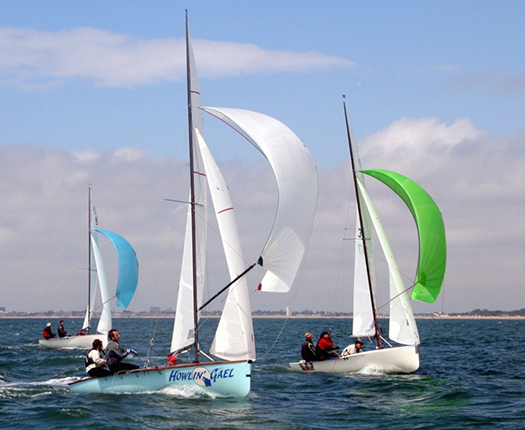
The furthest flung fleet is at Findhorn in northeast Scotland, but the huge distance involved doesn't stop Royal Findhorn YC boats competing with the rest of the class. This is top RFYC helm Stuart Urquhart's Howlin Gael racing in the Solent, and every so often the class – including those from Cork – make the long trek to Finhorn for an annual championship.
However, in terms of championship success the movement towards overall victory by glassfibre boats had begun, and 1977 saw the last championship win by a wooden boat, with Mike Kneale's Maid Mary (183) from the Port St Mary fleet in the Isle of Man. This was a hotbed of National18 racing for a couple of decades, and after Mike had completely renovated the 23-year-old formerly only so-so Maid Mary, he clinched the 1977 title at Findhorn in northeast Scotland "just before you get to Norway", as I was told in Midleton last month. There, the Royal Findhorn YC is a byword for warm hospitality ashore and hot sport afloat, but despite a strong challenge by a formidable Cork contingent, the Manxmen won out.
But having done his duty by the classic wooden boats, for 1979 Mike Kneale and his team took a different tack – they commissioned a new National 18 design from ace ideas man Jonathan Hudson, which they composite-built around Airex foam whose use other Manx DIY boat builders such as Nick Keig had been deploying for long-distance multi-hulls.

The Airex boat....Mike Kneale's innovative Woodstock on trials off Port St Mary in the Isle of Man in 1979.
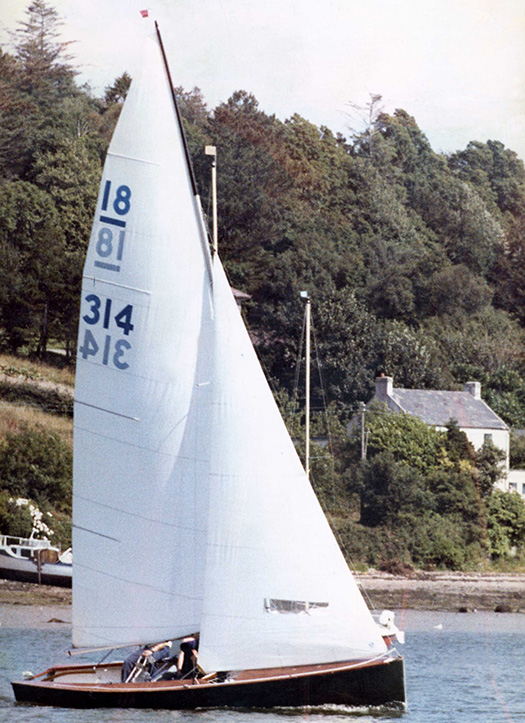
Woodstock from the Isle of Man sails back into Crosshaven in 1979 with all the look of a boat which has just won the championship.
Despite – or maybe because of – her composite materials, the new boat was called Woodstock. And as Brian Wolfe's history of the class recalls, when she appeared for the well-supported 1979 championship in Crosshaven, "there was much debate", not un-related to the fact that Mike and his crew of Rick Tomlinson and Ross Thomas swept the board, taking the championship for Mike's fourth time in a clean sweep with the top boat from the home Cork Harbour fleet being Albert Muckley's Eastern Promise (323) in second overall for East Ferry SC.
So where was Somers Payne? Well, after dominating the national championship leaderboards since 1958 with the wooden Melody, in 1979 Somers was making his first foray into campaigning a glassfibre boat, and while he may have been third, the writing was on the wall, and the class was moving to class.
And there was new life at Royal Cork. The Royal Cork YC's National 18s were having one of their periodic re-births, and while Woodstock may have won the title, her designer reckoned it was only by extra skill that they stayed ahead of a new wave of young talents whose helming skills had been honed in events like the Admiral's Cup and many national and international championships in all sorts of boats. Their zest for international competition was buoyed up by the knowledge that, back home in Crosser, they had ready-to-go racing in the National 18s which was not only great sport, but somehow much more fun than sailing in other boats.
This continued level of enthusiasm at all ages meant that when the National 18 pace showed any signs of slackening, the Cork Harbour division could be relied on to get things up and moving again. Thus when the changeover to glassfibre had become complete at the front of the fleet, with many other owners happy to race their vintage boats in a classics division, some of the Corkmen questioned why new glasfibre boats were still being built overweight in order not to out-perform boats which now saw themselves as a different part of the class in any case.
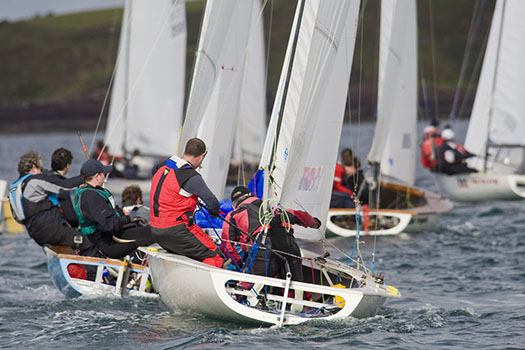
The National 18 fleet in Cork Harbour was mustering serious numbers with the lighter GRP boats from O'Sullivan's of Tralee. Photo: Bob Bateman
So the Crosshaven people got the moulds from England, and encouraged the moving of them to O'Sullivan's Marine in Tralee (incidentlally just about as far west on land as you can get from Whitstable in Kent), where they were used to build a whole new wave of lighter boats which became the National 18 class as most of us have known it until this year. Now, the new moves into the Phil Morrison boat are providing a fresh direction for a class which nevertheless takes careful steps to ensure that older boats have their place in the sun with a chance of realistic racing against similar craft.
Although Jeremy Vines of Tamesis and Lymington is the owner of the first of the new boats (she's number 401, and is called Hurricane in honour of the very first National 18 built by Anderson, Rigden and perkins in Whitstable in 1938), he is untinting in his praise for the energy and vision of the Cork harbour division of the class in having the idea and then promoting the new Phil Morrison boat, and he makes a particular point of applauding the very tangible support which has been given to the project by the Royal Cork Yacht Club.
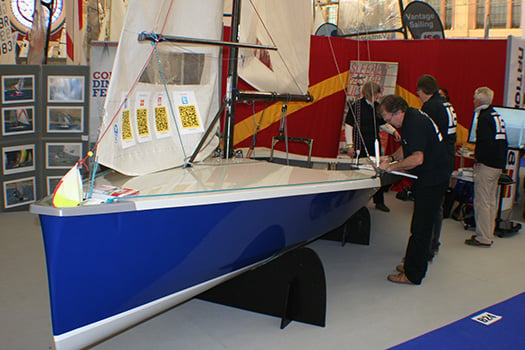
Into the blue.....Hurricane (number 406) is unveiled a fortnight ago at the Dinghy Show.
It's almost unfair, in such a community-based grass roots project, to single out anyone for special praise, but I got the feeling that folk like Colin Chapman, Dom Long and Tom Dwyer have been right there in the thick of it from the beginning.
The prototype having been tested and approved every which way, the moulds were made and the first dark blue hull emerged early in the New Year in one of the workshops which Rob White runs at White Formula Boats at Brightlingsea in Essex. So having been built at Tralee on the shores of the Atlantic for more than a decade, National 18 production is now back on the shores of the North Sea, but the spirit of the class at every location, regardless of where it might be, seems keener than ever.
The first of the new boats - of which sixteen have now been ordered – was Jeremy Vines' Hurricane, number 406, which was unveiled at the recent Dinghy Show in London. For a new generation which has been raised on the Phil Morrison-designed RS 200, this latest variant on the continuing National 18 story will speak volumes, and with eloquence. But it says everything about the spirit of this exceptional class that she rings a bell with seasoned National 18 sailors too.

The gang's all here. The new boat celebrated at the Dinghy Show with a group including many of those actively involved in its development, notably Colin Chapman, Tom Dwyer, Dom Long and Jeremy Vines.
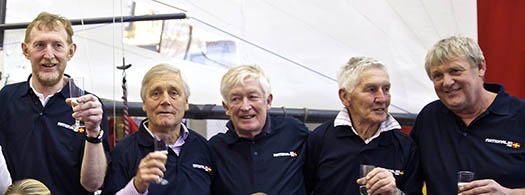
The movers and shakers are (left to right) Tom Dwyer of the Cork Harbour National 18s, designer Phil Morrison, Cork Harbour Class President Dom Long, Jeremy Vines (owner of the first boat to the new Morrison design), and Rob White of White Formula Boats
Irish 420 Dinghy Sailors Post Top Five Result at UK Inlands
#420 – Irish 420 dinghy sailors got the 2015 sailing season off to a great start with two top 5 results for Irish boats in the UK this weekend.
6 Irish 420s travelled to Rutland Water Sailing Club in Leicestershire for the 2015 420 Inland Championships.
For the UK sailors, this was the first in the 2015 Worlds and Europeans qualifying series, so racing was of a high standard in the two-day event, with a fleet of 49 competing.
Four races were completed on day 1 in sunny cold conditions with winds of 15 knots. Sunday was duller, and winds had dropped slightly, but an earlier start meant that the remaining three races of the series were completed.
UK youth pairing Clapp / Banham led from the beginning, but the Irish boats gave the home teams a run for their money, with Elmes / O'Sullivan (RCYC/HYC/MYC) finishing in second place overall, the UK's Burns / Shorrock and Davies / Keers in 3rd and 4th places, and RCYC's McCann / Whitaker taking 5th.
#mirror – The Irish Mirror Dinghy Association's winter training started this weekend in rather tricky weather conditions. 14 hardy sailors headed out on to Lough Ree in gusts of 20 knots on Saturday morning, under the excellent coaching guidance of Olympic 470 sailor and Mirror Sailing Champion, Ger Owens. The fleet were flying their spinnakers and Ger had them sailing some fantastic tight circles to keep warm and blow out those winter cobwebs. After a short break for lunch a couple ventured out, but some fierce 30 knot gusts came in and with a few young crew in the team it was quickly decided to head back to the warmth of Lough Ree Yacht Club for tactics coaching.
Sunday started at 9am rigged and ready to sail with blue skies and calm waters, then it soon picked up to gusts of 20–knots across the lake and just as quickly dropped to back light winds, heavy showers, then an incredibly thick snow blizzard. Those hardy sailors were having a ball out there, but coaching had to be called off due to poor visibility - they couldn't see the coach or the next mark! A return to base for snow ball fights and hot chocolates completed a rather "fluky" weekend.
Lough Ree Yacht Club (LRYC) host the Mirror training every year, offering free shed storage between training weekends and a warm welcome with log fire and wifi for the parents and essential hot pasta for the sailors. A massive thank you has to go to them for their support of the Mirror coaching.
The professional coaching by Ger Owens there each year really helps the Mirror sailors to develop their racing skills and the young sailors look forward to it extending their sailing season. Everyone is welcome and the storage facilities provided by LRYC for the boats makes training more accessible for sailors throughout the country and it less wear on the boats from travelling.
Just Who Do The Irish Sailing Association Think They Are?
#irishsailing – Ireland's national sailing authority has been going through turbulent times in recent years. With unprecedented expansion of ISA staff numbers as the country revelled in the boom years of the Celtic Tiger, the arrival of the inevitable and abrupt financial downturn found an Association bloated, unfit to cope, and out of touch with ordinary sailors.
High profile events, top level training and international participation had become so dominant in the ISA's range of activities that many of the ordinary sailors of Ireland already felt the Association was no longer relevant to their own low key personal pursuit of friendly sport afloat.
When the crash came, it led to a marked decrease in active sailing numbers as disposable incomes fell away. People focused on keeping their jobs and businesses afloat rather than their boats sailing, while many promising young sailors were forced to emigrate.
This new reality was reflected by the growing disillusion of club officers, who saw their membership subscriptions decreasing even while the ISA – which is largely reliant on subvention from the clubs for its own income – seemed always to be looking for more money. And at the height of the boom years, when all the major clubs had put through significant expenditure in developing their facilities to international standards, the ISA had shown its lack of contact with the reality of club life by proposing its own stand-alone National Sailing Centre in Galway, a facility which would in effect have been run in rivalry to the main clubs. To the mutterings in the grass roots were added the rumblings from above as major clubs threatened to withhold their annual payment to the ISA unless real reform was initiated. W M Nixon takes up the story.
In a classic grass roots revolution, club sailors Norman Lee from Greystones in County Wicklow and Bryan Armstrong from Sligo were at first rebuffed when they tried to voice their concerns about the ISA's increasing irrelevance to the needs of the vast majority of sailing enthusiasts, people at local level who were doing their very best to keep the sport alive through torrid times.
The Irish sailing community now owes these two men and their supporters a debt of gratitude, for they believed in what they were saying and they refused to be turned aside. Eventually, in November 2013 moves were in place to establish a Review Group for the urgent analysis of all ISA activities, and its personnel drew comprehensively on Ireland's remarkable pool of people with hands-on experience of running successful sailing events and organisations.
It was chaired by Brian Craig of Dun Laoghaire who has headed up the organising team on more major and notably successful international sailing events in Dublin Bay than probably anyone else, and its able personnel included two former ISA Presidents - Roger Bannon of Dun Laoghaire and Neil Murphy of Malahide and Howth - who had both been noted for their skill in running a tight ship when they were in charge. With them was highly regarded International Race Officer Jack Roy of Dun Laoghaire, and renowned sailmaker/activist Des McWilliam of Crosshaven, who each year is inevitably seen in busy involvement afloat in more Irish sailing centres - large and small - than anyone else in the boat world.
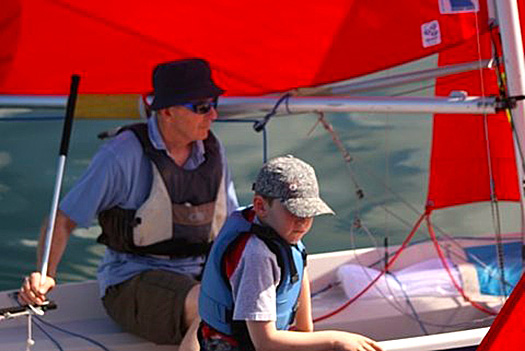
Bryan Amstrong of Sligo on the helm for a Mirror race
Also on board was one of the men from the barricades, Bryan Armstrong of Sligo. His background in a relatively remotely-located club which nevertheless has a long and distinguished sailing history made him uniquely qualified to voice the concerns of the grass roots. And we have to remember that all these people were giving voluntarily and generously of their time to this project in a period when Irish life was largely a matter of just getting through each day, while staying economically afloat was something of an achievement.
Primarily, the Review Group's function was to analyse the Association work on behalf of ordinary club sailors, as it was agreed that the Olympic and High Performance Divisions of the ISA's activities – which receive direct Sports Council grants – were in effect functioning as a different entity.
The Strategic Review Group was still work in progress when the ISA acquired a new President in David Lovegrove in March 2014, but by August the SRG published proposals which led to the setting up of a more formal body, the Planning Group. If this seems like a case of kicking the can down the road, it was anything but - these were people in a hurry, they'd got through the first stage of analysing areas where action was required, now they had to be more structured in coming up with clearcut ideas and concrete proposals.
This new Planning Group, which went into action in early Autumn 2014, was chaired by Neil Murphy, and its members included ISA President David Lovegrove, ISA Board Member Brian Craig, Ruth Ennis, Peter Redden, Sean Craig, and ISA CEO Harry Hermon, with noted Dun Laoghaire events administrator Ciara Dowling to provide administrative support.
They had their draft plan ready by mid-December 2014, and on January 21st 2015 Neil Murphy and his group publicly unveiled their analysis and proposals for the first time at a well-attended and very representative meeting in the Royal St George YC in Dun Laoghaire.
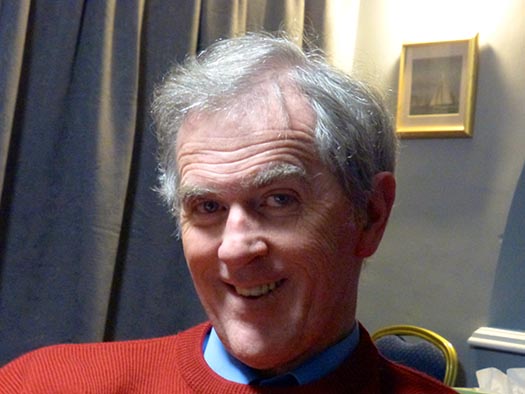 Neil Murphy is a former ISA President who, in addition to extensive experience as a Race Officer, is a typical club sailor, racing a Puppeteer 22 out of Howth. Photo: W M Nixon
Neil Murphy is a former ISA President who, in addition to extensive experience as a Race Officer, is a typical club sailor, racing a Puppeteer 22 out of Howth. Photo: W M Nixon
While those involved in setting the ISA on a healthier course are mostly working on a voluntary basis, it has to be said that the PowerPoint presentation and the printed material was of the highest professional class. In fact, it was much better than many professional shows I've been to, and the level of thought which went into a wide range of questions from the floor answered by Neil Murphy, Brian Craig and David Lovegrove generated a growing level of goodwill which concluded with Norman Lee voicing his congratulations and good wishes for this continuing process in which he and Bryan Armstrong had played such a key role.
So now we move on to the next stage – taking the ideas to the rest of the country. Doubtless you'll have noted the double meaning in titling this piece 'Just Who Do The ISA Think They Are?' In a first interpretation, that question is the one for which, let's hope, we are all now involved in working together in providing and implementing a satisfactory answer.
But equally, as the ISA Road Show gets out of Dublin to take this excellent presentation to a public meeting in Cork next week (it's in the Rochestown Park Hotel on Tuesday, Feb 17th, 7.0 pm to 9.0 pm) and then Galway the week after (Galway Bay Sailing Club, Tuesday 24th February 7.0 pm to 9.0pm), they'll be taking themselves into areas where experience of sailing administration long pre-dates the establishment of organised sailing on Dublin Bay.
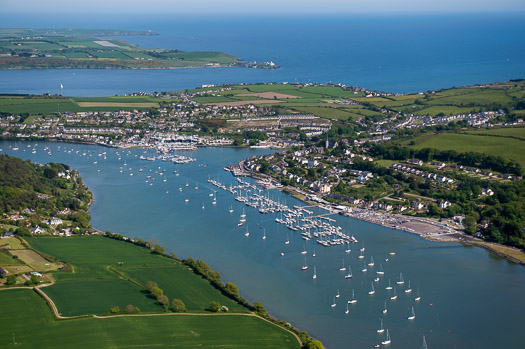 Crosshaven in the summer time. When we look at the natural advantages to be found here, it's little wonder that structured recreational sailing on Cork Harbour long-pre-dated any organised sport on Dublin Bay. Photo: Robert Bateman
Crosshaven in the summer time. When we look at the natural advantages to be found here, it's little wonder that structured recreational sailing on Cork Harbour long-pre-dated any organised sport on Dublin Bay. Photo: Robert Bateman
So you might well ask just just who do they think they are, these people from Dublin, going down to Cork to try to tell them how sailing should be organised? The nerve of them, doing it in a place where they've had organised sailing since 1720, and where the two biggest clubs – the Royal Cork and Kinsale – are both mighty establishments of international sailing repute which would remain so even were the ISA to disappear overnight in a puff of smoke...
And as for going west along the road to Galway, that will take them through Athlone where the Lough Ree Yacht Club dates back to 1770, while on the west coast the Royal Western of Ireland YC at Kilrush traces its origins back to 1828. Equally, further north along the Atlantic coast Sligo YC dates back to 1821, and in Lough Erne the club began in 1820. Yet the first club on Dublin Bay, the Royal Irish, only began as recently as 1831, and even then it barely hung in and had to be revived in 1846, with the pace being set in the meantime by the Royal St George YC, founded 1838.

Kinsale is another harbour which seems to have been designed with sailing primarily in mind. Photo: Kevin Dwyer/courtesy ICC

Kilrush on the Shannon Estuary had a club in being before there were any sailing institutions on Dublin Bay. Photo: W M Nixon
So in terms of sailing administration history, Dublin and Dun Laoghaire are only Johnny-come-lately places by comparison with just about everywhere else in Ireland. Yet thanks to the inevitable dominance of economic development, population growth and the strengthening centres of political power, we now find that sailing administration and decisions of national import are emanating from a place that, in terms of natural sailing advantages, lags far behind the rest of the country.
Oh for sure, Dun Laoghaire Harbour is a fabulous artificial amenity, and the advent of the new marina at Greystones has already been seized upon as greatly increasing the "cruising" options of Dublin Bay. But let's face it, Dublin Bay is really only good for racing, specific day sailing and training, whereas Cork Harbour and Kinsale provide such a variety of opportunities for interesting race courses, mini-cruises with multiple destinations and what have you, that in effect they're not just in a different part of the country – they're a different country altogether.

Dun Laoghaire is a totally artificial facility, and sailing options on Dublin Bay are limited. But it's inescapable that this is the primary point of leisure access to the sea for Ireland's largest and most affluent population. Photo: Kevin Dwyer/courtesy ICC
All of which adds to the difficulties of creating a meaningful national authority with which every sailing person can identify.
This business of Dublin v The Rest is not unique to sailing, of course, but when you have a specialist sport with multiple sub-branches of activity, the problem is exacerbated.
So please bear this in mind if you take yourself along to the meetings in Cork or Galway during the next ten days. This really is a genuine attempt to base the ISA within the sailing community at an everyday level of usefulness to all, with scope for growth while enhancing existing structures, and input from the sailing community at this stage will help in developing the ideas and initiatives proposed.
While the draft ISA Strategic Plan 2015-2020 very definitely puts the emphasis back on to the need for healthy well-run clubs as the basis for the sport, there was initially a feeling at the meeting on January 21st that the new-look ISA is not supportive of commercial sailing schools. In fact, what the new-look ISA hopes to do is encourage training schemes within clubs, while at the same time supporting commercial sailing schools where the demand is such that no club could realistically cope while maintaining its essential club ethos.
Going into this in more detail in a personal meeting this week with Neil Murphy, who is a Chartered Quantity Surveyor, we talked around the fact that a thriving club scene is central to the spirit of Irish sailing, and he was musing on the success of Sutton Dinghy Club where Hugh Gill heads up what is in effect a commercial sailing school within a club setting.
In fact, what Murphy would hope to see emerge at larger population centres is sailing's equivalent of the public golf course. Anyone who has used a public golf course will be aware that the proprietors are usually mustard keen to encourage the formation of a "club" within their customer base, and there is no reason why this shouldn't eventually take root in Irish sailing, providing access to sailing at a fraction of the cost of joining an established club.
It's not something which can realistically be objected to by established clubs trying to protect their own membership, as the people who would use a "public sailing club" would be those who simply couldn't afford to go sailing at all in the current traditional club setup.
Nevertheless support for the established club setup is central to the new Strategic Plan, and the provision of Regional Development Officers to serve clubs directly is very much to the fore in the new thinking. But in looking over the figures published with the report, it's good to note that the ISA works with no less than 80 recognised training centres, while an encouraging statistic is that there are now 24 secondary schools in Ireland which include sailing as a regular part of their curriculum. Admittedly it's a long way from the French setup where every schoolkid is entitled by law to one week of sailing and one week of skiing per year, but in a country where an aversion to being on the water used to be thought inevitable, it's a step in the right direction.
All these considerations of inexpensive sailing are a whole world away from the stories of recent weeks and days about the ISA's High Performance Division seeking a fund-raising executive who will be tasked with finding €2.75 million per annum through philanthropic and other donations in order to help the funding of top level campaigns which we're not allowed to call Olympic campaigns, as apparently that is copyrighted by the Olympic Council, so we call them High Performance instead.
But apparently Government departments aren't restricted by this limitation on the use of the word Olympic, for it was bandied about like nobody's business in this week's news that the government is spending mightily through the Sports Council, with sailing being number three in all Ireland in terms of current Sports Council funding, with a total tag of €1,289,900.
Of course it's not all for specifically Olympic sailing, but it covers 103 sailors from Optimists to the Olympics. Which is fine and dandy for those who are mad keen to race at the highest level, but most sailors in Ireland are much more interested in performing well within their chosen area and boat class, but with sailing being just part of a reasonably civilised and well-balanced life.
And as became evident at the meeting on January 21st, there's an increasing number of people who feel that sailing needs to realise that there's a sizeable population out there of folk who'd like to go sailing, but don't feel the almost religious vocation to own a boat.
With the rapid expansion of sunshine sailing holidays with boats and equipment readily available for hire at the destination, there's a strong feeling there's a real need for more of this in Ireland, even if we can't guarantee the sunshine. The suggestion brings us back to both the "public sailing club" concept, and the growing realisation by established clubs that they have to reach out to potential members by having boats available for sailing on a trial basis.

The Affordable Sailing Team – Norman Lee (right) with his brother Ken beside their campervan at last year's GP 14 Worlds at East Down YC on Strangford Lough. Photo: W M Nixon
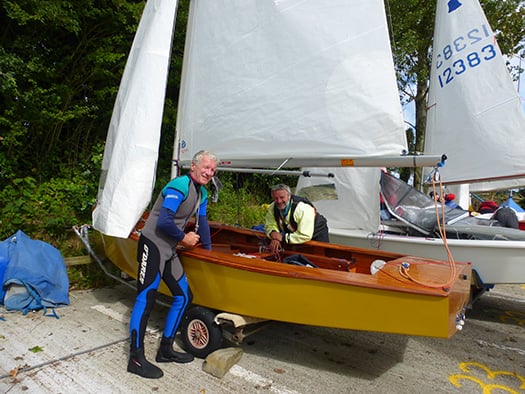
With their own very high can-do standards of boat maintenance, Norman and Ken Lee can keep their GP 14 in the competitive frame. Photo: W M Nixon
That said, the need to own one's own boat and tune and tinker with her to your heart's content is what sailing is all about for many of us, and Norman Lee is a classic case in point for this approach. He claims that his sailing costs him just €600 per year, though that of course is after he has paid for his well-tuned GP14, and he has long since written off the cost of the vintage camper-van which is home to the Lee Equipe when they hit the campaign trail.
Nevertheless the entire setup has to be outstandingly good value, and doing it in such economical style is part of the fun of it all. So when someone with Norman Lee's approach to sailing is prepared to get up at the big ISA public meeting in Dun Laoghaire and congratulate the team who have been working on the reforms which he and Bryan Armstrong set in train, then that is approval of a high order.
And as for just who or what is the ISA, can we maybe agree that ideally we all are the ISA, every last one of us who goes sailing or is even just interested in the sport, and it's up to us to keep it in line and encourage it to identify with and serve the ordinary sailor every bit as much as the high-flyer.

Private pleasure.....the 2014 GP 14 Worlds at East Down YC is about as high as many Irish sailors would expect or want to aim, and many are content with much lower-key regular club sailing. Photo: W M Nixon
RS400 Adds to Kinsale Yacht Club Frostbite Series
#kinsaleyachtclub – Day two of the ASM Kinsale Yacht Club frostbite series saw typical frostbite weather, cold, bright, sunny with near perfect sailing conditions. The wind was 10–knots gusting to 12.5 from NNW. Each of the 5 fleets got 3 great races in shifting conditions which made it a great test for all competitors. Each of the fleets had close racing, especially the ever popular Squib Fleet.
Race Officer & KYC Sailing Secretary, John Stallard was delighted to see the arrival this week of the RS400 fleet which has added greatly to competition and made for a beautiful spectacle in the bright sunshine on Kinsale inner harbour.
Maeve Leonard from RCYC appeared out today in the Laser Radial fleet and produced 3 bullets to dispense with all opposition. Her club mate Luke McGrath achieved the same result in the Laser 4.7 fleet.
The Full rig fleet was smaller today and the field is led by Monkstown's Ronan Kenneally followed by Club mate Paul O'Sullivan.
In the Squib fleet KYC's Colm Dunne and Rob Gill have an astonishing result of 6 bullets after 6 races, they are hotly pursued by KYC's Commodore Finny O'Regan and his son Colm.
Sail number 1260 takes the lead in the fledgling RS400 fleet.
Racing continues next week....

Squibs on a Run
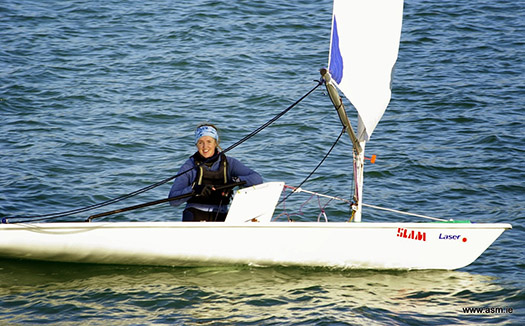
Maeve Leonard of RCYC looking happy with 3 wins from 3 races
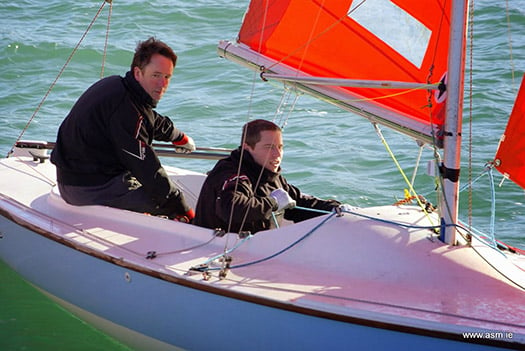
KYC's Colm Dunne & Rob Gill in their Squib Allegro, in the lead with 6 bullets after 6 races...
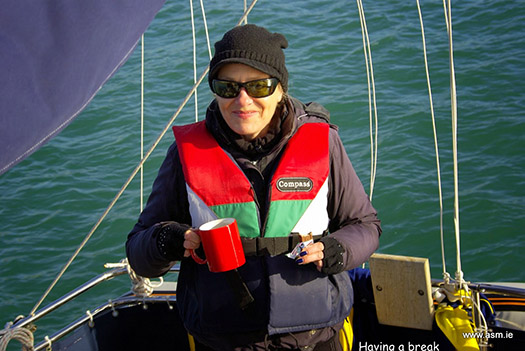
Committee Boat stalwart Sue Horgan

Lasers heading to Castlepark
All photos courtesy of Seamus McLaverty of ASM Marine
DMYC Frostbite Dinghy Racing Cancelled Again Due to Strong Winds
#dmycfrostbites – With both XCWeather and Windfinder forecasts suggesting similar conditions for 15:00, northerly winds of 20 knots with gust to 27/28 knots, air temperatures of 5/6˚, but, ironically sunny conditions, the organisers of today's DMYC Frostbites pulled the plug on the Dun Laoghaire dinghy racing series writes Cormac Bradley. N over A flies from the DMYC flagpole for yet another week!
Dinghy Fest 2015 – Royal Cork Yacht Club Launches Major Small Boat Racing Event for 2015
#dinghyfest2015 – The Royal Cork Yacht Club (RCYC) and more than seven Irish dinghy classes have launched a Cork Harbour Dinghy racing fesival for 2015. As Afloat.ie reported in October the 'Dinghyfest 2015' will consist of four days of 'world class' racing, with courses inside and outside Cork Harbour. Dinghy fest 2015 will run from 20th to the 23rd of August.
Irish class associations have confirmed that they will be holding the following events during the 4 day regatta:
• RS200 - Euro Cup & National Championships
• RS Feva National Championships
• RS 400 Southern Championships
• Mirror National Championships
• 420 Nationals Championships
• Topper Munster Championships
• National 18 Southern Championships
There will also be mixed dinghy racing as well as an Optimist championship.
Announcing the event, Nicholas O'Leary, 'Dinghyfest 2015' Director of Sailing said:
"I've been moniitoring the growth of dinghy sailing over the past number of years and believe the time is now right to get all fleets together and host a National Dinghy Festival. I'm delighted that we will be hosting Dinghyfest 2015 at the Royal Cork Yacht Club. Over the last year or so I've seen a lot of old competitors and good mates migrate back to our roots of the dinghy classes. Graduates of old from the social Intervarsity Team Racing Circuit are now picking up affordable dinghies like the RS's, Lasers and Mirrors to name but a few. The latest to get into the dinghy craze is Ireland's Figaro "Full Irish" Campaigner, David Kenefick, who will join over a dozen RS 400's now racing in Cork Harbour.
"There's a fair amount of dinghy sailors who want to get together to race hard and renew friendships forged in their youth sailing days. Expats further afield will hopefully come to the party and Dinghyfest 2015 will facilitate those sailors coming home to compete and hopefully bring sailors, from the UK and beyond , to enjoy what Cork Harbour has to offer. We have four race courses planned and will look at rotating classes to challenge the tactical skills of all, with the varying conditions which each race area will present."
Dinghyfest 2015 will encompass a number of Class Championships with two, three and four days racing planned depending on the requirements. An overall Dinghyfest Championships will combine results for three days racing from the 21st to the 23rd and the finer elements will be detailed within the NOR and SI's. Entries for all events will be through the dedicated RCYC website which will be live on 1st February.
Sutton Dinghy Club's Andy Johnston is December's Sailor of the Month
#sailorofthemonth – Sutton Dinghy Club on the north shore of Dublin Bay has been a pace-setter in the revival of Irish dinghy racing and club activity generally during 2014. Commodore Andy Johnston led his members through an outstanding season in which they were once again making an impact at national and international level, while the club's training programme and sailing school under the direction of Hugh Gill was highly effective in bringing newcomers to the sport, and building up a strong esprit de corps among its dedicated team of young instructors. In addition to success in open dinghy events at all levels, SDC succeeded in regaining the historic Book Trophy for team racing from Royal Cork Yacht Club.
The trophy dates back to 1944, but for the past sixteen years the sailors of Crosshaven had kept it firmly in their grasp. 2014 also marked the 75th Anniversary of the foundation of the club at its homely base beside Sutton Creek, so the concluding highlight of the year was a 75th Anniversary Gala Dinner in mid-November in the club's home-from-home, the popular Marine Hotel at Sutton Cross. A remarkable total of 204 well-wishers and people who have distinguished sailing connections with Sutton DC from way back attended.
It was Ciara O'Tiarnaigh and her Organising Committee who looked after the nuts and bolts of this star-studded event, but throughout a long and very special season, it was Andy Johnston who led the way and held the ultimate responsibility. Nevertheless, in making him our Sailor of the Month for December 2014, we are saluting the spirit of Sutton Dinghy Club, and the resilience of all Irish dinghy sailing.
Foynes Yacht Club Dinghy Fleet Numbers On The Rise
#foynes – Foynes Yacht Club dinghy fleet has exploded this summer and is going from strength to strength writes Elaine O'Mahoney. It started with a conversation in the club bar in the latter part of the summer amongst a small number of members where it was agreed a revival of dinghies in the club was needed and the Laser One was the preferable choice. Club members scoured the country and within a few weeks the fleet went from one laser to ten.
The yacht club has had a excellent season with take up in the both the Adult Learn to Sail Programme run by Alan Mc Eniff on Wednesday nights throughout the season and the Foynes Yacht Club Sailing Academy helping the younger members of the club get to grip with our beautiful sport using the club owned Topaz & Oppie dinghies. For the first time in many years the academy has travelled to open dinghy events in local clubs in Dingle, Tralee and Cullaun Sailing Clubs. The pathway has also been created for the juniors starting in the academy on the Topaz to move onto either purchase their own dinghy, join the Dublin Bay Mermaid fleet or start sailing with the cruiser class.
Saturday mornings were a busy time for the club with supervised dinghy sailing taking place throughout the season which according to Commodore James McCormack has laid the foundations for the renewed interest in dinghy sailing in particular with the junior members. The Saturday morning sailing concluded with a one day regatta at the end of September in which there were 27 boats taking part, of which, five were lasers owned by club members. By the end of the first Laser Series which was run during October there were ten lasers competing for the top spot.
So while the cruisers lifted out at the end of October the introduction of the Laser dinghy fleet meant that the season was extended for some with the Laser November Series, which concluded last weekend after completing a full race card schedule of 10 races. The club are very grateful for the support of Brian O'Sullivan from O'Sullivan's Marine in Tralee who sponsored the October Series and Peter Clifford from Clifford's Cash and Carry in Tralee, sponsor of the November Series.
Racing will take a break for December and January and return on Saturday mornings in February. The club have appointed their first Laser Class Captain, Cathal McMahon, who will have a busy 2015 given the rate at which lasers are appearing at the club. Currently the fleet is up to an astonishing sixteen boats and rumour has it Santa Clause will be bringing another laser or two to Foynes this Christmas!
2015 Sailing Calendar Includes Two Bicentenaries & Ireland's Biggest Regatta At Dun Laoghaire
Irishsailing – After the remarkable across-the-board success of the 2014 Irish sailing season, 2015 will have to be very special indeed to be remembered with such enthusiasm. But it's a special year in any case, as two major sailing Bicentenaries – one in the Irish Sea, the other in the Solent – will have added and poignant meaning, as the Centenaries a hundred years ago could not be celebrated because of the First World War.
As for Irish sailing generally, life moves on, there are new sailors on the water, successful young sailors are graduating to the next stage of their rapidly developing careers, and established stars continue to plan fresh campaigns, for sailing is indeed a sport for life.
Then too, new fixtures successfully introduced in 2014 will require nurturing, tuning and encouragement if they are to fulfil their potential in the coming year, while at the same time there's always extra effort needed to give proper support to established fixtures, which have to live with the reality that they might wilt through being taken for granted. Both new and longer-established boat classes will need continued enthusiastic involvement, and our well-loved classics and traditional craft must be cherished and sailed, for lack of use is the real enemy of boats, whether old or new.
As for the major administrative initiatives introduced in 2014, they will need constant monitoring, but deserve full support from the sailing and boating community at large, for it was in response to a grass-roots initiative that the radical and very necessary reforms of the Irish Sailing Association were undertaken. Those appointed to undertake the root-and-branch reform of the national authority have done so with commendable dispatch, so it is now the duty of the rest of us to support their continuing efforts. And we can best do that by enjoying our boats and our sailing and time afloat in its myriad of interests, while encouraging others to do the same. W M Nixon outlines on what the coming year may bring.
One thing at least is certain for the coming season afloat during 2015 in most of Europe. It will not mark any significant sailing Centenaries. Instead, we are immersed in four years of remembering the Great War of 1914-1918 a hundred years on, with all the added twists of that period's longer historical narrative in Ireland. In such a context, it may seem frivolous to point out that sports like yachting have no great Centenaries to mark at all in 2015. But this minor off-screen fact is a reminder of the all-involving horror and obscenity of total warfare on an industrial scale. It obliterated anything like normal life.
Yet as recreational sailing had been going on in some sort of organised form for hundreds of years – albeit in a fairly rudimentary way in its earliest years in the 16th Century – there may well have been several important dates to be marked during the time of the Great War itself, but they were allowed to pass as there was no sport afloat, while civilian life ashore was very subdued.
And in Ireland, with the Troubles persisting for four years after the end of the Great War until 1922, the Bicentenary of the Royal Cork Yacht Club in 1920 was to be a muted affair – the official History of the Royal Cork Yacht Club (published 2005) tells us: "Plans for a special dinner to celebrate the club's bicentenary in 1920 had to be cancelled, probably because of the disturbed conditions in the country"
So the idea of celebrating the Centenary of the Royal Yacht Squadron in Cowes in 1915 at the height of the international war - other than in a rather solemn shorebound way - would have been unthinkable. But that in turn fuels the celebrations when the peacefulgood times roll again. Thus the Royal Cork Yacht Club, having been unable to celebrate its Bicentenary in 1920, went on to have a fabulous two-year Quarter Millennium celebration in 1969-70. And as the RYS couldn't have a proper party in 1915, there's no doubt that the up-coming Bicentenary in 2015 will be the nucleus of international sailing's megafest-of-the-year.
There are of course several clubs which pre-dated the Squadron when it was founded in 1815. And there are many whose members outshine the small membership of the RYS in the breadth and energy of their sailing. But for 2015, let's just acknowledge that the prestigious Squadron has been at the heart of sailing history for a very long time, while their clubhouse's location right on the Solent at Cowes is so central that when any great Solent-related events are under way, the Squadron is in the middle of the story.
Thus it was on the Squadron lawn that in July that the Irish team celebrated their epic Commodore's Cup victory at the end of July 2014. And it will be towards the Squadron and its Bicentenary that the fleet will be racing in 2015's west-east Transatlantic Race. And then it will be the firing of the cannons from the historic Squadron battery which will signal the start of the 46th Fastnet Race on 16th August 2015.
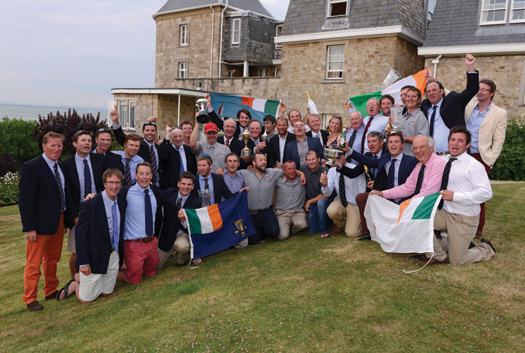
Party time at the Royal Yacht Squadron – the Irish team and their management gather to celebrate victory in the Commodore's Cup at the Squadron Castle in Cowes on August 1st 2014
There'll be many Irish boats involved, and the best-placed of them at the finish will be the winner of the Gull Salver, currently held by Martin Breen's Reflex 38 Lynx from Galway Bay SC, which was skippered to success by Aodhan FitzGerald in 2013's race. It's a coveted trophy, instituted to honour the memory of Harry Donegan of Cork and his famous cutter Gull, which was one of seven boats which inaugurated the Fastnet Race in 1925, and placed third. Since then, Irish Fastneteers have frequently been in the great race's top places, and best of all was in 2007 when Ger O'Rourke's Cookson 50 Chieftain out of Kilrush, sailing under the burgee of the revived Royal Western of Ireland YC, came sweeping in to the finish line at Plymouth to win the Fastnet Race
overall.
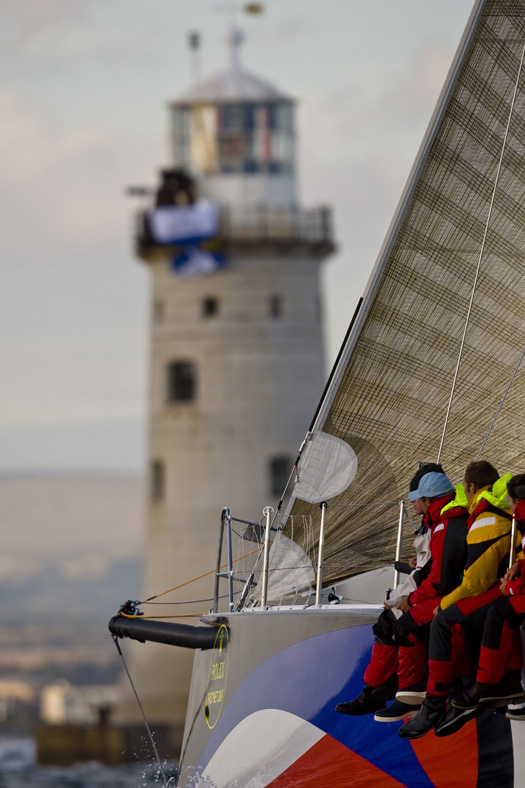
One of the greatest moments in Irish sailing history – Ger O'Rourke's Chieftain sweeps towards the finish line to become the overall winner of the Rolex Fastnet Race 2007. Photo: Rolex
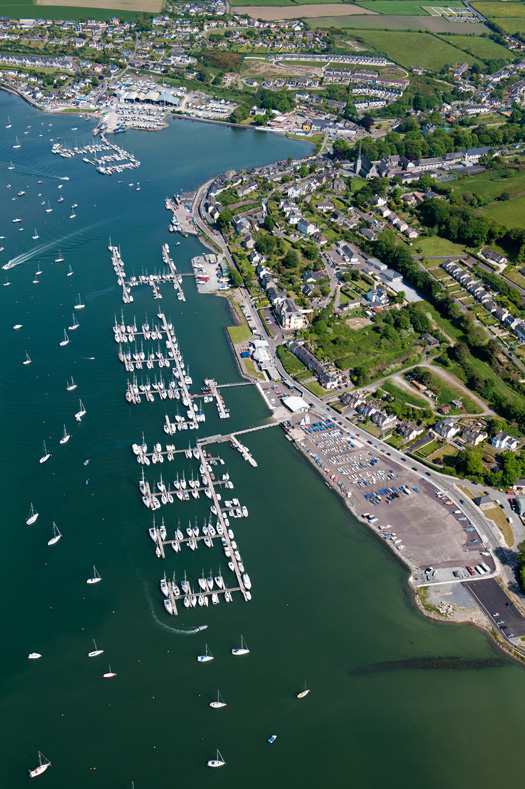
Just the spot for a great Tricentenary celebration - the very complete sailing facilities provided jointly by the Royal Cork Yacht Club and Crosshaven will become a world focus in 2020 with the Club's 300th anniversary. Photo: Bob Bateman
The realisation that 2015 sees this significant RYS Bicentenary is a timely reminder that the Royal Cork's Tricentenary is only five years down the line. They're five years which will be gone in a flash, and already behind-the-scenes moves are afoot to ensure that the national sailing programme will properly facilitate the extraordinary anniversary being celebrated in Crosshaven in 2020.
But meanwhile other Irish sailing centres have their own regular programmes to operate in the intervening four years, and in terms of numbers and scale there's no doubt the top event in Ireland in 2015 will be the biennial Volvo Dun Laoghaire Regatta from 9th to 12th July.
Anyone – and there were many - who took part in this unique "suburban sailfest" in 2013 will know that the VDLR has come of age. It's an event which is comfortable with itself while at the same time being always in development and evolution mode. Each staging of this remarkable Dublin Bay happening sees lessons being learnt and implemented even while the multi-class racing is under way on several courses. And in the two year gap before the next staging, the experience gained is closely analysed and the programme refined to further improve the sport in every area.
You get some idea of the sheer depth of racing experience in Dun Laoghaire by noting that the Chairman of the 2015 Committee is Tim Goodbody, with Martin Byrne as Vice Chairman while the Race Director is Con Murphy. And those three sailing megastars are just the peak of a mountain of race administration experience which is being drawn in from all over Ireland to ensure that the fleet of 400-plus boats gets the best sport possible.
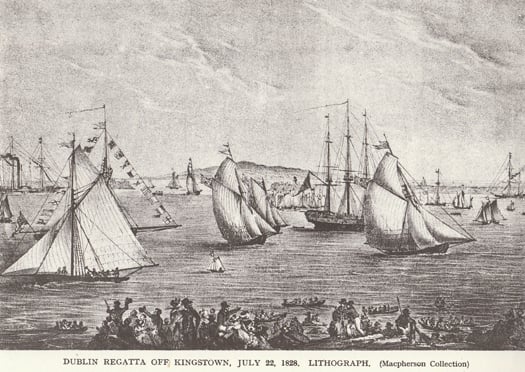
The first regatta in 1828 at the new harbour at Dun Laoghaire, which will be the setting for Ireland's biggest event in 2015, the Volvo Dun Laoghaire Regatta from 9th to 12th July.
While there'll be keenly participating boats from all over Ireland as well as Scotland, England and Wales, the setup of Dublin Bay being right on the city's doorstep means that it's the locals who would pose an administrative problem for a less experienced team. As the dates for the VDLR approached in 2013, the weather forecast steadily improved, and thanks to the Regatta's "extra long weekend" format, the sudden arrival of summer meant that a host of boats from the greater Dublin area came in as last minute entries, their owners and crews managing to scrape the extra day-and-a-half needed off work. It's a scenario which would put an overstretched administration off course, but the VDLR team took it calmly in their stride, and the result was a successful summer festival of sunlit sails and great sport, with maybe two thousand taking part.
This year there's a more structured cross-channel involvement, as the venerable Royal Dee YC in Cheshire has leapt to life to celebrate its Bicentenary. Founded as the Dee Yacht Club in 1815 with the end of the Napoleonic Wars, it didn't get the Royal seal until 1947, but nevertheless claims to be older than the RYS. With growing fleets in North Wales and the Mersey, it has put together a Bicentennial Royal Dee Irish Sea Offshore Championship linked closely to ISORA, which will bring the fleet across to Ireland to take in four offshore day races sailed as part of VDLR 2015.
Irish National Championships which will be part of the VDLR 2015 programme include the J/109s, the RS Elites, the Beneteau First 21s, and the Wayfarers, while the Leinster GP 14 Championship is also included as an integral part of the Regatta.
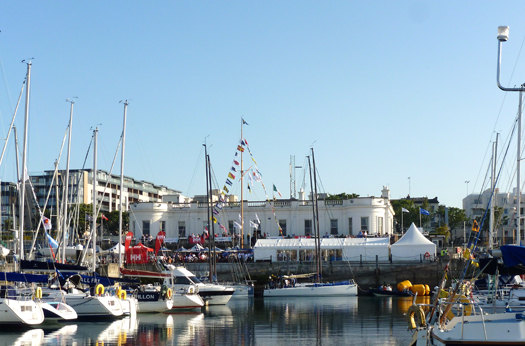
Party time in Dun Laoghaire – the Royal Irish YC during VDLR 2013. Photo: W M Nixon
As for Ireland's classic clinker-built vintage classes, one of the pleasantest surprises in VDLR 2013 was the large turnout of Mermaids, which had superb racing on the course area in the northwest corner of Dublin Bay. Despite having been born as the Dublin Bay SC Mermaid in 1932, this class of 17ft super-dinghies is no longer included in the regular DBSC programme owing to shortage of numbers for weekly turnouts. But it seems that as far as the VDLR is concerned, the Mermaid is now an event boat, and the fleets still thriving at other centres, together with some of the dormant Dublin Bay craft, bestirred themselves for the four days to enjoy good sailing for more than three dozen boats, something which is highly likely to be repeated in 2015.
The even more venerable Water Wags, founded 1887 with the current boats dating from 1903, continue to thrive in Dun Laoghaire, and the word is they expect to have at least twenty boats in action, while another wooden classic, the Mylne-designed 25ft Glen keelboat, is 50 years and more in Dun Laoghaire, and looks forward to having at least twelve boats racing in 2015.
All these specialized and historic classes are in addition to the numerous cruiser-racers which continue to be the backbone of Dublin Bay sailing. And while many of them will see the VDLR 2015 as a highlight of the year, in turning to consider the overall national programme, we find a sport which is shaking off economic recession to get on with an extraordinary plethora of local, national and international sailing events.
The problem is that most events of significance hope to locate themselves in the peak sailing period from late May to early September, so clashes are almost inevitable, and if you're interested in several different kinds of sailing, the overall choices can be bewildering in their complexity and logistical challenges.
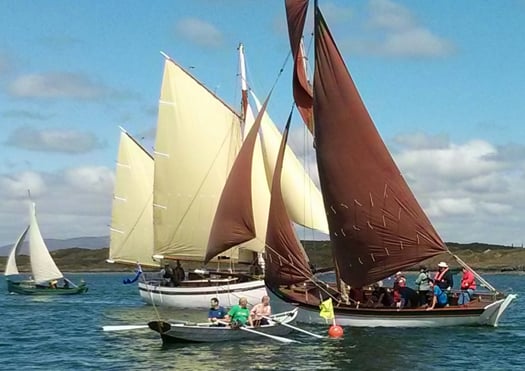
The Baltimore Wooden Boat Festival attracts an eclectic fleet – included here are a Shannon Gandelow, a West Cork Mackerel Yawl, the ketch Sile a Do, and an Heir Island Lobster Yawl (left).
For instance, the variety of events now available for the traditional and classic boats – usually but not necessarily under the Old Gaffer umbrella – would keep anyone busy for most of the summer. It starts with the Baltimore Wooden Boat & Seafood Festival from Friday 22nd May to Sunday 24th May, which you'd think very early
in the season for someone faced with fitting out an old wooden boat in Ireland's climate, but somehow they do it.
Then on the East Coast for the early summer Bank Holiday Weekend from May 29th to June 2nd, there's the Old Gaffer gathering in Dublin Bay at Poolbeg Y&BC with the annual race for the Leinster Trophy in the bay on Saturday May 30th, the event then morphs into the Dublin Port Riverfest in the Liffey on Sunday May 31st, and finally it all concludes with the race for the Asgard Trophy back in the bay on Monday June 1st.
The annual Lambay Race at Howth, a regular fixture since 1904, has seen its course becoming increasingly complex in modern times in order to satisfy the desire of modern racers for competition on every possible point of sailing. But in 2014, to celebrate the Centenary of the Lynch family's Echo, the venerable Howth Seventeens were sent on the traditional course north from Howth Harbour through the sound inside Ireland's Eye, then on round Lambay leaving it to port, and then back south inside Ireland's Eye again to the finish at Howth pierheads.
This was such an attractive proposition for Old Gaffers and Seventeens alike that on the day an extra Classics Division was added to cater for ancient craft, and it hit the spot. This option will be offered again for 2015's Lambay Race (it's on Saturday June 6th), and the word is that Dickie Gomes's 1912-built 36ft yawl Ainmara will be coming down from Strangford Lough to defend her title after 94 years. 94 years? Yes indeed - she won the Lambay Race in spectacular style in 1921 when still under the ownership of her designer-builder John B Kearney.
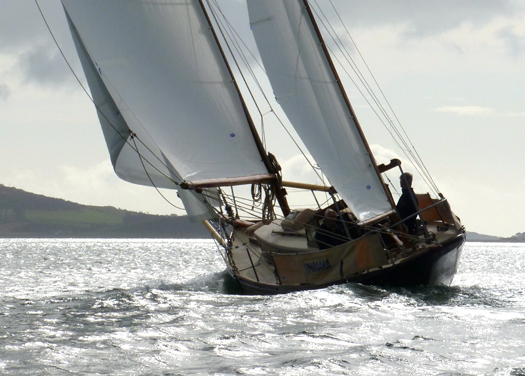
After 94 years, Dickie Gomes's 36ft 1912-built yawl Ainmara (seen here on her home waters of Strangford Lough) hopes to return to defend the title in Howth's Lambay Race, which Ainmara won in 1921 while still in the ownership of her designer-builder John B Kearney. Photo: W M Nixon
The Old Gaffers attention then swings north as the Tall Ships are coming to Belfast from Thursday 2nd July to Sunday 5th July. This is going to be a serious biggie with those ships already signed up including a significant turnout of Class A vessels, which are square riggers and others of more than 40 metres in length. Belfast Lough lends itself particularly well to the Parade of Sail which follows a Tall Ships gathering, and in 2009 when they were last in the port they put in in a virtuoso display with the Dutch ship Europa in particular going to the trouble of getting herself over towards Whiteabbey in the northwest corner of the lough to allow her time get every stitch of sail set before proceeding seawards down-lough in colossal style, a much more impressive display than we've become accustomed to in Dublin, where the shape of Dublin Bay is such that it doesn't really provide the space for square riggers to set all cloth before getting out to sea.
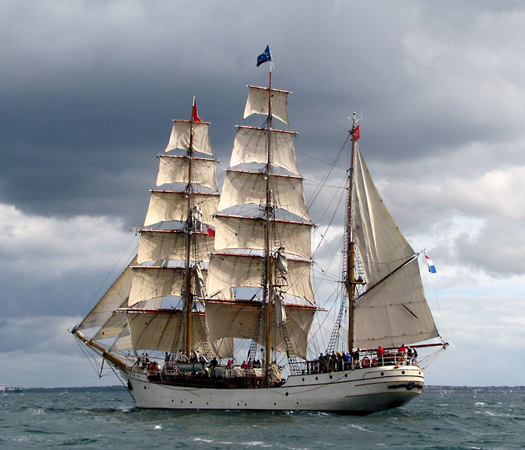
The Tall Ship Europa shows how it should be done in Belfast Lough in 2009, taking time out to set full sail before she starts to gather power to make the proper input into the Parade of Sail.
Like Dublin, Belfast has shown it can be hospitable to Old Gaffers, and it was a very welcoming main port during the OGA Golden Jubilee Cruise-in-Company in 2013, so for 2015 the OGA National President Sean Walsh hopes to up the ante by persuading his members from all round the Irish Sea to gather in Belfast, and to add spice to the mix, he hopes to persuade the Howth 17s to put in an appearance as well, to sail with local one designs like the 1903 Belfast Lough Waverley Class, which have been experiencing a revival in recent years.

Old Gaffers in Belfast for their Golden Jubilee in 2013. The Irish Sea classic and traditional fleet will return to the same venue for the Tall Ships gathering in July 2015. Photo: W M Nixon
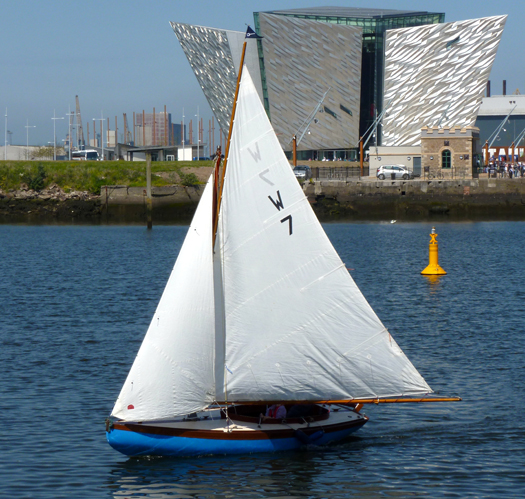
The Belfast Lough Waverley Class Lilias (built 1903) sailing at the Titanic Centre in Belfast. In 2015, the Waverleys will be joined by some of the 117-year-old Howth 17s to participate in the visit of the Tall Ships. Photo: W M Nixon
The Seventeens have made long treks as a class before – in 1998, five of them were road-trailed to Carrickfergus to mark the class's Centenary, with the first five boats built by Hilditch of Carrickfergus. So though they'd trailed there, they then sailed the 90 miles back to Howth, just as the first boats had done a hundred years earlier. Then in July 2003, fifteen of the Seventeens took part in the Glandore Classics Regatta thanks to a brilliantly organised exercise in logistics using a flotilla of low loaders which could take three boats apiece.
For all of Ireland's classic and traditional boats in 2015, and an international fleet too, Glandore is very much up on the radar again, as a special effort is being made by a GHYC team led by Donal Lynch to encourage increased numbers in the CH Marine Glandore Classic Regatta from Saturday July 18th through Friday July 24th. It's a date which certainly allows Old Gaffers plenty of time to get down from Belfast, indeed some may even consider the option of making the voyage northabout to take in a round Ireland cruise while they're at it. And as that great magnet of the Irish Sea classic and traditional scene, the Peel Traditional Boat Weekend, isn't until Friday 31st July to Sunday 2nd August, it's just about possible to factor that in as well.
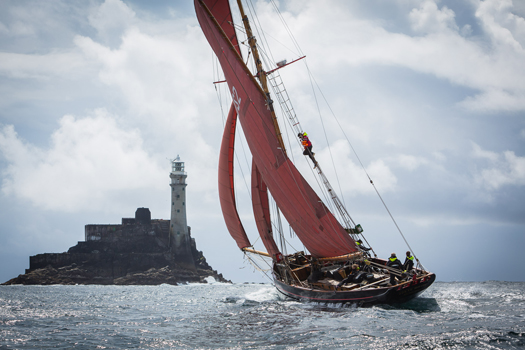
Everything happening at once – the famous Pilot Cutter Jolie Brise was the star of the Glandore Classics in 2013, and as it was her own Centenary she celebrated by sailing round the Fastnet Rock – she has been a successful Fastnet Race participant several times. Photo: Brian Carlin
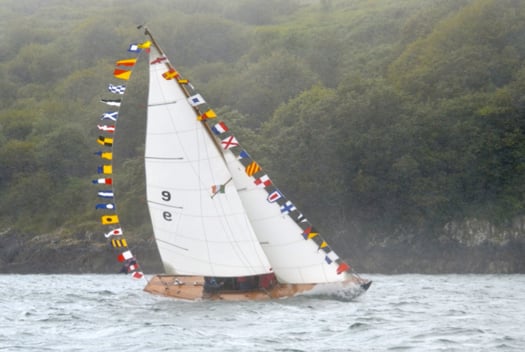
The Glandore Classics attracts an international fleet, and 2013's regatta included a class of Fife One Designs from the Menai Straits, all of them keen to party and showing it. 2015's Glandore Classics is from July 18th to 24th. Photo: Cormac O'Carroll
All this is already happening for the oldies with August barely under way, yet for modern cruiser-racers the potential programme for any keenly-sailed Irish boat is equally complex, attractive and challenging. The season starts as usual with the Scottish Series from Friday 23rd May to Monday 26th May – there'll probably still be snow on the mountains of Arran. They've gone back to their roots by starting with a feeder race from Gourock to the main regatta centre at Tarbert on Loch Fyne. "Going back to the roots" is something of a theme for this year's staging of the Clyde Cruising Club's main racing event, as this is the 40th Scottish Series. Come to think of it, there are so many important 40th anniversaries happening in sailing these days that we have the admit that the decade which brought us the full horror of wide lapels and flared trousers also contributed some lasting elements of the international sailing scene, indeed it could be said that the modern era in sailing really began about forty years ago.
Back in Ireland, the ISORA programme will be well under way by June, while the Lambay Race on June 6th can be looked at with more interest by several boats, as the biennial National YC Dun Laoghaire to Dingle Race doesn't start until Friday June 12th . Last time round, there was a total fixtures clash between the two events, but in times before that hyper-keen sailors such as the Tyrrells of Arklow with Aquelina have been able to fit in both, indeed one year they did it so well they won both too, and were rightly acclaimed as the Afloat "Sailors of the Month" for their success.
For 2015, defending champion in the Dingle Race is Brian O'Sullivan of Tralee with the veteran Oyster 37 Amazing Grace, which came good in the end in 2013 with a new breeze which knocked pending leader Antix (Anthony O'Leary) off the winning perch. But with the 2015 Dingle Race acting as a useful if rather indirect feeder for the Covestone Asset Management Sovereigns Cup in Kinsale from June 24th to 28th, there could be all sorts of sharp boats lining up to take the prize, for the Sovereigns Cup 2015 includes the all-singing all-dancing ICRA Nats 2015.

The welcoming port – Kinsale is one of Ireland's most popular destinations, and in 2015 its hosts the combined Sovereigns /ICRA Nationals from June 24th to 28th.

Perfect sailing – racing in the Sovereigns at Kinsale in June 2013. Photo: Bob Bateman
Yet the timing of the combined Sovereigns/ICRA Nats is such that there's still plenty of time and space to get back to the Irish Sea for the Volvo Dun Laoghaire Regatta 2015 from July 9th to 12th, a reminder that much of the cruiser-racer programme for 2015 is in a neatly balanced and user-friendly timescale for everyone except perhaps those who wish to do either the entire ISORA or SCORA programme as well, so the problem mostly is going to be getting time off work.
And for the hyper-keen cruiser-racers, particularly those whose boats are small enough to be conveniently trailerable, further temptation looms in 2015 with the WIORA Championship at Galway Bay Sailing Club from July 22nd to 25th. For the fleets in the Shannon, on Tralee Bay, and in Clew Bay, it's a bit more than a day's sail away, but they'll be there to challenge Liam Byrne of the home club who won it in 2014 with his Corby 25 Tribal at Mayo SC in Clew Bay, while some top boats from more distant centres are expecting to trail to Galway Bay to spice up the competition.
By this stage of the season a more relaxed pace might be welcome, but the lively turnout of 80 boats in 2014 for the new-style four day Cork Dry Gin Calves Week out of Schull in early August (Tuesday 4th to Friday 7th August in 2015) suggests that for racing sailors, the best relaxation is more racing, but in a holiday setting. And yes, it has been noted that a true West Corkian sailing nut could indeed do all of Calves Week 2015, and still be on the Squadron line for the start of the Fasnet Race nine days later.
For dinghies in 2015, the big story is the debut of the newest version of the National 18, and just how popular will the Bray-bult foiling Moths become, while established classes will frame their programmes to accommodate sailors whose time is limited, also having to fit in with a national scene where the number of Race Officers with the necessary skills is inevitably a finite amount.
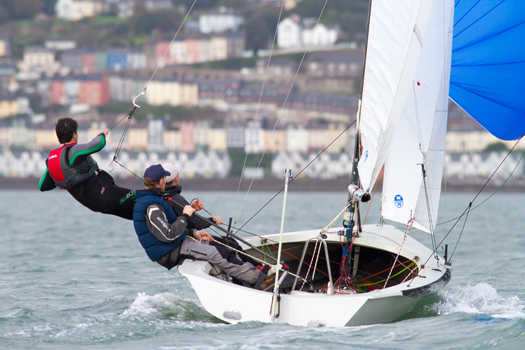
The big stories in Irish dinghy racing in 2015 will be the arrival of the new National 18s at Crosshaven, and the revival of Dinghy Week there in late August. Here, in the Autumn of 2013, To Dwyer and Nin O'Leary test sail the prototype of the new 18 on Cork Harbour. Photo: Bob Bateman
The new Third Generation (or maybe it's fourth or fifth generation) National 18 may have been designed in England by Phil Morrison, and is being built there too. But it was the very active Crosshaven fleet with the Royal Cork Yacht Club which led the charge towards a new boat, and when it came to stepping up to the plate to pay twelve substantial new boat deposits to move it all along after the prototype had been rigorously tested in Cork harbour last Autumn, it was the Crosshaven fleet that provided eight out of those twelve cheques.
So it's entirely appropriate that in August 2015, the dinghy focus will swing big time towards Crosshaven and a short form "Dinghy Week" from August 21st to 23rd. The old style Irish Dinghy Weeks – the last one was in 1970 – became victims of their own success, they just got too large. But the different classes became over-optimistic about their continuing individual growth prospects. Then the pendulum swung too far the other way, and dinghy classes were alone and their events shrinking. But a resurgence of club and championship dinghy sailing in Crosshaven during 2014, and a growing realization that over-reliance on single-handed dinghy classes does not necessarily produce a socially-adjusted national squad of junior sailors, resulted in some clear and creative thinking about developing two-handed boats, and reviving some old classes such as the Mirrors.
The form of this new Dinghy Week is still in the melting pot, but at least eight classes have responded with enthusiasm. Meanwhile, the National 18s in Crosshaven will be such a focus of interest during 2015 with the first of the new boats making their debut that we'll have a season-long dinghy narrative developing on Cork Harbour, and the revived Dinghy Week will be just part of it.
As for inshore keelboats, the big one in terms of number is the combined British and Irish Championship Squib Championship at Howth from 27th June to 3rd July. The handy little Squibs are something of an oddity, as they serve so well as a cherished local class in so many Irish sailing centres that many owners see them as that, and nothing more – handy little club sailors to be raced on home waters a couple of times a week.
This means that when a major regional or national event is held, the number taking part will often only be a fraction of the total Irish Squib fleet. But for those who do make the trek, the competition is fierce and the racing great – in Howth, the high point was in 1996, when this "Nationals" event attracted a fleet of exactly a hundred boats, and on one never-to-be-forgotten morning, there they were, every last one of them on the starting line.

A hundred Squibs all in a row at Howth on Tuesday July 25th 1996. Photo: Mandy Murnane
The most recent Squib event of national stature was the Freshwater Keelboat Regatta at Dromineer on Lough Derg on the weekend of October 18th-19th, and the battle for the top places was between the Kinsale and Belfast Lough fleets, with James Matthews and Rob Jacob of Kinsale rounding out their year in style with a good win.
But with the Squibs in England undergoing a revival – they were the second-biggest One Design fleet in Cowes Week 2014, bested only by the legendary XODs – there's no doubt there's a strong challenge coming across channel, and any Irish boat getting into the top ten will be doing well.
As for that annual Autumn Freshwater Keelboat Regatta at Dromineer, while it may have been much hampered by the spinoff from some ferocious weather out in the Atlantic with frustration for some of the sixty boats hoping to take part, it's an event of enormous potential, and the many who wish it well and have enjoyed it in the past will be ready and willing to do their part to make 2015's regatta a success.

The Squibs enjoying a lull in the strong winds during the Lough Derg Freshwater Regatta 2014. Overall winner was Mucky Duck (no 51, James Matthews & Rob Jacob, Kinsale YC). Photo: Gareth Craig
All these specialised and localized events planned for 2015 will be the continuing background music to the usual events of national sailing focus, everything from the selection of the Irish team for the Student Yachting Worlds to the Helmsmans Championships to the steady increase in pace while 2015 develops as the pre-Olympic year. As the year rolls along, other stories will develop too. So perhaps it's appropriate that we exit this review as we entered it. Just pause to remember now and again that, a hundred years ago, you simply couldn't have gone freely afloat like this for sport and recreation at all.
But we can't close on such a solemn note. Seasoned Solent sailors may have noted our header photo from Guido Cantini at the Panerai Classics Regatta was looking just slightly odd, for some reason difficult to pin down. Well, as it happens, the photo was sent to us back in September just as we were contemplating the excellent cleanup up done by Jason Hurley of Jason Hurley Design on the Mercedes-sponsored billboard photo of Howth 17s on the end wall of Howth Yacht Club. As with many photos taken over the RYS starting cannons, the Cantini pic included an obtrusive part of the Fawley Oil Refinery across on what Isle of Wight people call "the north island". Though Fawley has been there for yonks, it still has the look of a temporary structure. So we got Jason to treat as just that. But here for your edification is the true picture. You could get a taste for this sort of thing. What about brushing out Whitegate, lads? And as for Milford Haven.........
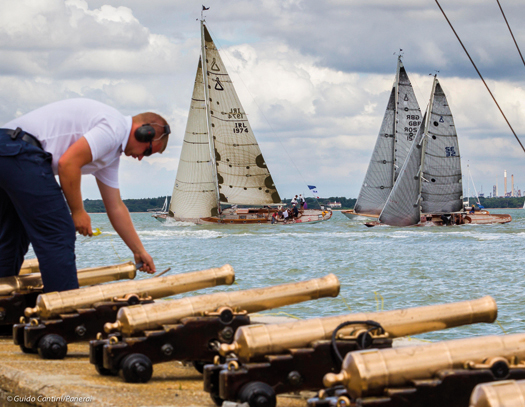
The unvarnished truth. In real life, the view from the RYS battery at Cowes can be slightly marred by the clutter of Fawley Refinery across the Solent on "the north island". Photo: Guido Cantini/Panerai
Read also: 2015 Irish Sailing Fixtures List (provisional)





























